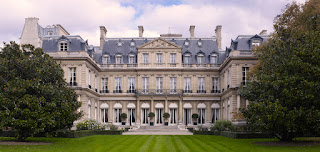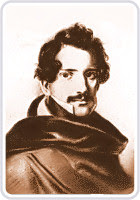Roman who made his mark on Paris
| The French painter Théophile Vauchelet's portrait of the architect Louis Visconti |
Notably, Visconti was the architect chosen to design the tomb to house the remains of Napoleon Bonaparte after King Louis Philippe I obtained permission from Britain in 1840 to return them from Saint Helena, the remote island in the South Atlantic where the former emperor had died in exile in 1921.
Born Louis Tullius Joachim Visconti, he came from a family of archaeologists. His grandfather, Giambattista Antonio Visconti was the founder of the Vatican Museums and his father, Ennio Quirino Visconti, was an archaeologist and art historian.
Ennio had been a consul of the short-lived Roman Republic, proclaimed in February 1798 after Louis Alexandre Berthier, a general of Napoleon, had invaded Rome, but was forced to leave with the restoration of papal control.
He and his family moved to Paris and were naturalised as French citizens, with Ennio becoming a curator of antiquities and paintings at the Musée du Louvre.
 |
| Visconti's magnificent tomb for Napoleon Bonaparte, in red porphyry on a granite base, standing 16ft high |
He was was appointed by the city in 1826 to oversee building works in the 3rd and 8th arrondissements and subsequently as curator of the 8th section of public monuments, which comprised the Bibliothèque Royale, the monument on Place des Victoires, Porte Saint-Martin, Saint-Denis and the Colonne Vendôme.
He became divisional architect in 1848, and government architect in 1849.
In May 1848, he produced a first-draft design for completing the Palais du Louvre. He was made architect to the Palais des Tuileries in July 1852 and architect to Napoleon III the following year.
 |
| The Hôtel de Pontalba in Rue du Faubourg-Saint-Honoré, now home to the US Ambassador to France |
Among several large houses he designed, the Hôtel de Pontalba in Rue du Faubourg-Saint-Honoré, built in 1839, is an outstanding example.
Hôtel de Pontalba is an example of an hôtel particulier, a type of large townhouse. It was commissioned by New Orleans-born Baroness Micaela Almonester de Pontalba. Nowadays, it is the official residence of the United States Ambassador to France.
During his time as the official architect for the Louvre under Napoleon III, he was commissioned to design the tomb for Napoleon Bonaparte.
Louis Philippe had arranged for Napoleon’s remains to be brought to France in 1840 and they were first buried in the Chapelle Saint-Jérôme in Hôtel des Invalides, the complex of buildings in the 7th arrondissement of Paris that contains museums and monuments relating to the military history of France, as well as a hospital and a retirement home for war veterans, the building's original purpose.
The buildings include the Dôme des Invalides, the tallest church in Paris at a height of 107m (351ft), which contains the tombs of some of France's war heroes. It became Napoleon’s final resting place in Visconti’s magnificent, dramatic tomb, crafted in red porphyry on a green granite base, circled by a crown of laurels, standing 5m (16 feet) high and 4.5m wide.
 |
| The remains of the Forum of ancient Rome attract some 4.5 million visitors every year |
When the new Roman Republic was declared in 1798, its supporters symbolically gathered in the Foro Romano, the remains of the Forum of ancient Rome, a rectangular piazza (square) surrounded by important government buildings at the centre of the city. For centuries the Forum was the centre of day-to-day life in Rome, a market place but also the venue for public speeches, criminal trials, elections and triumphal processions. Statues and monuments were built to commemorate the city's great men. Located between the Palatine and Capitoline Hills, the Forum today attracts some 4.5 million visitors every year.
Find a hotel in Rome with Booking.com
Travel tip:
The Vatican Museums, located inside the Vatican City, display works from the immense collection amassed by popes throughout the centuries including several renowned Roman sculptures and some of the most important masterpieces of Renaissance art in the world. The museums, founded by Pope Julius II in the 16th century, contain roughly 70,000 works, of which 20,000 are on display. The Sistine Chapel, with its ceiling decorated by Michelangelo, and the Stanze di Raffaello, decorated by Raphael, are on the visitor route through the Vatican Museums, which are visited by some six million people each year, making in the fifth most visited art museum in the world. The museums employ a full-time staff of 640 people.
More reading:
Why Luigi Vanvitelli was the 18th century's most celebrated architect
How architect Giovanni Battista Vaccarini reshaped Catania in Sicily
The founding of the papal Swiss Guard
Also on this day:
1881: The birth of Futurist painter Carlo Carrà
 |
| Caravaggio's The Entombment of Christ is among the Vatican's art treasures |
The Vatican Museums, located inside the Vatican City, display works from the immense collection amassed by popes throughout the centuries including several renowned Roman sculptures and some of the most important masterpieces of Renaissance art in the world. The museums, founded by Pope Julius II in the 16th century, contain roughly 70,000 works, of which 20,000 are on display. The Sistine Chapel, with its ceiling decorated by Michelangelo, and the Stanze di Raffaello, decorated by Raphael, are on the visitor route through the Vatican Museums, which are visited by some six million people each year, making in the fifth most visited art museum in the world. The museums employ a full-time staff of 640 people.
More reading:
Why Luigi Vanvitelli was the 18th century's most celebrated architect
How architect Giovanni Battista Vaccarini reshaped Catania in Sicily
The founding of the papal Swiss Guard
Also on this day:
1881: The birth of Futurist painter Carlo Carrà
1917: The birth of film director Giuseppe De Santis
1929: The Lateran Treaty declares the Vatican an independent state
1948: The birth of footballer Carlo Sartori
1929: The Lateran Treaty declares the Vatican an independent state
1948: The birth of footballer Carlo Sartori
1995: The birth of singer Gianluca Ginoble
(Picture credits: Napoleon Bonaparte's tomb by Son of Groucho; Hôtel de Pontalba by Mouloud47; Rome Forum by Rennett Stowe; via Wikemedia Commons)
(Picture credits: Napoleon Bonaparte's tomb by Son of Groucho; Hôtel de Pontalba by Mouloud47; Rome Forum by Rennett Stowe; via Wikemedia Commons)
(Paintings: Portrait of Visconti - Musée Carnavalet, Paris; Caravaggio's The Entombment of Christ - Pinacoteca Vaticano, Rome)



